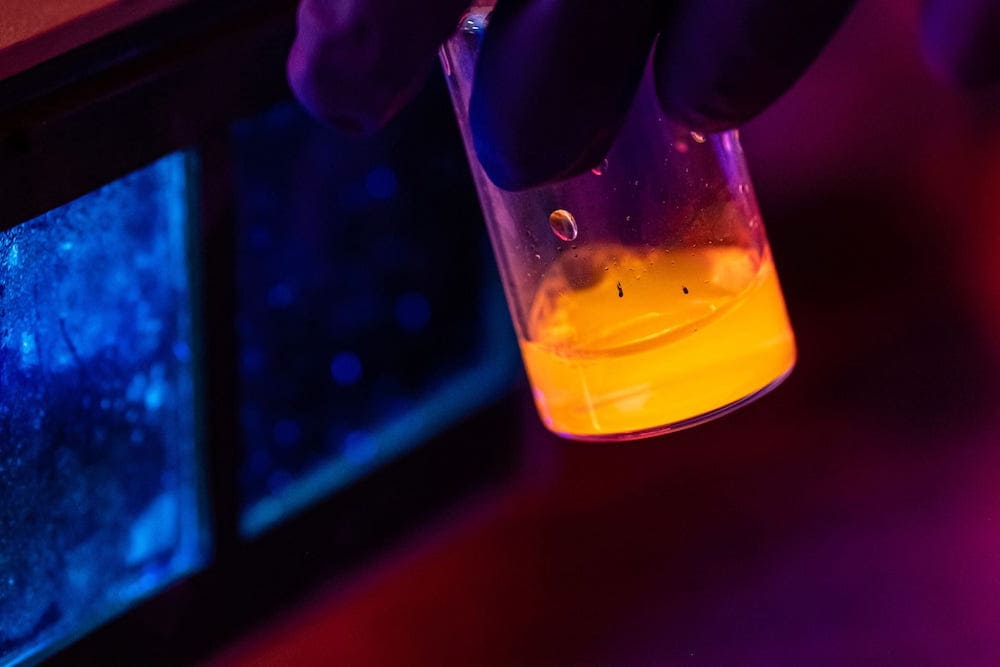
[Image above] Rice University graduate student Ashleigh Smith McWilliams holds a vial of fluorescing boron nitride nanotubes. She and colleagues captured video of the nanotubes in motion to prove their potential for materials and medical applications. Credit: Jeff Fitlow, Rice University
Boron is the darling of the glass industry—borate glasses are used in everything from pharmaceuticals to displays, lighting, insulation, and more.
In the field of nanomaterials, though, the story is quite different—studies on boron-based nanomaterials are far behind those on carbon, the giant of the nanomaterials field.
Carbon-based nanomaterials have received much more attention than other nanomaterials since the discovery of graphene in 2004. But in recent years, researchers have expanded their investigations of other nanomaterials as well—and boron is one element that has benefitted greatly from these expanded studies.
Boron-based nanomaterials such as borophene and boron nitride nanotubes (BNNTs) have superior and complementary properties to carbon-based nanomaterials. For example, borophene is stronger and more flexible than graphene, and BNNTs are electrically insulating rather than conducting (the opposite of carbon nanotubes).
There still is much to learn about the structure and fundamental properties of boron-based nanomaterials, and studies are constantly ongoing. For example, I covered a study on understanding the crystal structure of borophene last year. Now, a new fundamental study has been published investigating how BNNTs move in solution.
Before we get into the details of the study, you may be wondering why understanding movement in solution is important. The Rice University researchers who conducted the new study waste no time answering this question in their introduction.
“Understanding how BNNTs diffuse in solution is paramount to producing aligned films and fibers, as it provides a time scale for relaxation and reorientation,” they write. “Additionally, knowing how BNNT diffusion compares to that of other materials, such as polymers, can allow us to design composites that maximize BNNTs’ desired properties.”
The researchers also emphasize the importance of such information in biomedical applications, such as drug delivery.
“[Knowing] how BNNTs behave in aqueous solution will allow us to more accurately predict their response to changes in environmental parameters, such as viscosity or temperature. This is particularly pertinent to biological studies where changes in environment are quite common,” they write.
Unfortunately, investigating the real-time dynamics of BNNT dispersion can be surprisingly difficult because BNNTs are highly polydisperse, meaning the distribution of chain lengths and molecular weights in the BNNT structure is nonuniform. Common ensemble techniques used to investigate dispersion, such as dynamic light scattering, require uniformity to work best and thus do not help in this case.
Fortunately, there is a technique that allows for real-time dynamics studies at the level of an individual particle or molecule—fluorescence microscopy.
Fluorescence microscopy uses an optical microscope that detects fluorescent light to study the properties of organic or inorganic substances.
“This technique has been previously utilized to measure diffusion and bending dynamics information for single-walled carbon nanotubes and germanium nanowires, as well as to perform ground-breaking dynamics studies on many biomolecules,” the researchers write.
The researchers previously showed BNNTs can be individualized in solution (made to not clump) when dispersed in a mixture containing surfactants, i.e., a substance that reduces the surface tension of a liquid and thus increases its spreading properties. In this study, the researchers used surfactants hosting a fluorescent molecule (rhodamine B) so fluorescence microscopy could be used for analysis.
They took videos of the dispersion (see below), which they used to calculate translational and rotational diffusion coefficients. These values then were compared to predicted values for a rigid rod experiencing Brownian motion, i.e., the random motion of particles caused by collisions with other molecules in a suspending fluid.

Credit: Rice University, YouTube
The calculated and predicted values aligned, indicating BNNTs do act like rigid rods, just like carbon nanotubes. And this knowledge will have “important repercussions” on future developments, the researchers say.
“… knowing that BNNTs diffuse similarly to many rigid polymers and other nanomaterials can aid our design and manufacturing of composites that can translate to the macroscale the BNNTs’ nanoscale properties,” they write.
“Moreover, since the experimental results for BNNTs fit the theoretical model so well, we can use established theories for crowded rods to predict how the BNNTs’ environment, e.g., confinement size, affects their diffusion,” they add. “This will be particularly useful for biomedical studies, where confinement in the cytoskeleton can dramatically change the dynamics of rods.”
In a Rice University press release, professor and chair of the Department of Chemistry Matteo Pasquali says these results should help the community move much faster toward applications.
“For example, we could make fibers and coatings that are thermally conductive but electrically insulating, which is very unusual as electrical insulators have poor thermal conductivity,” he says.
The paper, published in The Journal of Physical Chemistry B, is “Real-time visualization and dynamics of boron nitride nanotubes undergoing Brownian motion” (DOI: 10.1021/acs.jpcb.0c03663).
Author
Lisa McDonald
CTT Categories
- Basic Science
- Nanomaterials


